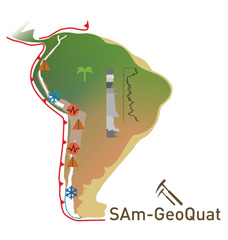

South America constitutes a unique transect for studies of past global changes across most climatic belts of the Southern Hemisphere. The late Cenozoic geotectonic evolution resulted in three morphostructural domains: (i) a mountain belt in the west (Andes), (ii) a corridor of central lowlands (foreland basins) and (iii) the old terranes in the east (craton). During the Quaternary, a series of landforms and sediments has evolved in response to major land-forming processes involving the tectonic/volcanic, fluvial, colluvial, glacial, aeolian, lacustrine and marine systems.
Many parts of such a geologically dynamic continent had evolved during the Quaternary from tectonic and volcanic processes that created significant changes in the landscape, mainly affecting the Andean region. Although the most conspicuous dynamic processes in the Andes were glacial, physical weathering and mass transports have been very important.
The highlands are presently dominated by geomorphological processes related to climatic regimes ranging from humid tropical to periglacial. During the Quaternary, changes in the character and or the intensity of denudation processes produced mainly extended planation surfaces and associated deposits.
The major alluvial basins (Amazon, Orinoco, and Paraná) mostly lie under warm humid/subhumid climates. Their fluvial landforms represent important information about the nature of environmental changes in tropical latitudes. Large areas of their river basins (the Orinoco Llanos, the Pantanal, the Pampa and Chaco plains and the Bananal plain) and extensive parts of Patagonian plains contain important sand dunes fields and many deflation hollows. A large part of the Chaco-Pampa plain is covered with loessic materials. Then, the main components of the Quaternary Geology in the lowlands are alluvial megafans, loess-paleosol sequences, dune fields, extensive wetlands and lacustrine sequences. The arid and semi-arid regions contain also evidence of the existence of Quaternary lakes of great importance (the Altiplano/ Puna plateau and Patagonia).
Quaternary
landforms marking different palaeoshorelines reflects
the interplay between the different heights of global seal level and the
nature and rate of vertical movements in the coastal zone (the
elevated marine terraces of the Caribbean coast, the marine terraces of
the Atlantic coast and the Amazon and Parana deltas, the elevated terraces
of the Chilean and Peruvian Pacific coast, and the submerged quaternary
shorelines of the Argentine shelf).








